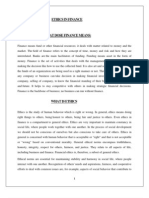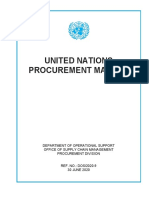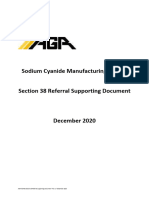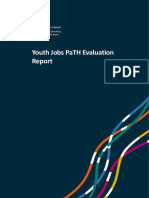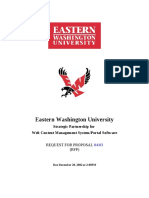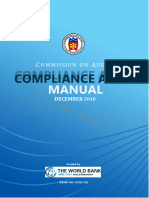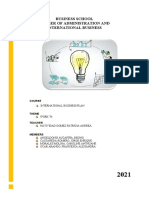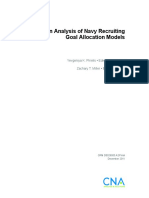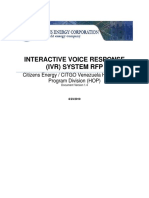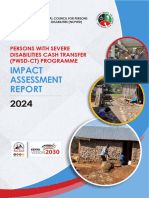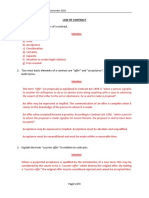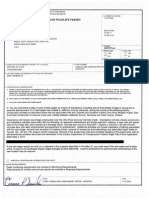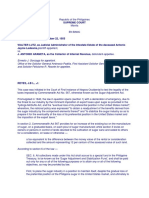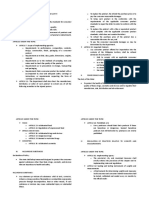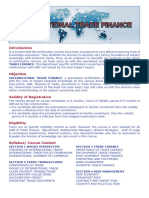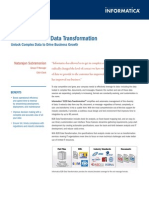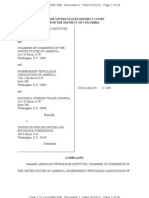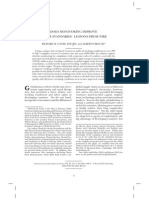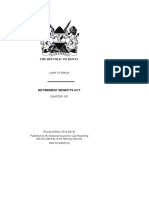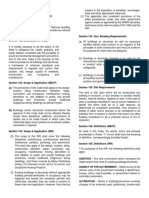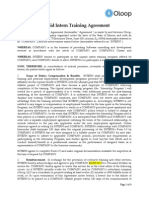A&A Lifecycle Guide PDF
A&A Lifecycle Guide PDF
Uploaded by
alcastillomCopyright:
Available Formats
A&A Lifecycle Guide PDF
A&A Lifecycle Guide PDF
Uploaded by
alcastillomOriginal Title
Copyright
Available Formats
Share this document
Did you find this document useful?
Is this content inappropriate?
Copyright:
Available Formats
A&A Lifecycle Guide PDF
A&A Lifecycle Guide PDF
Uploaded by
alcastillomCopyright:
Available Formats
USAID ACQUISITION LIFECYCLE ORIENTATION GUIDE
Date:
Responsible Office:
File Name:
USAID Acquisition Lifecycle Orientation Guide Page 1
Contents
Cross References ............................................................................................................................. 4
Acronyms ........................................................................................................................................ 4
References: ...................................................................................................................................... 7
Key Roles and Responsibilities ...................................................................................................... 9
Preface…....................................................................................................................................... 10
1.0 Planning (Pre-Solicitation) Phase .................................................................................. 10
1.1 Program Cycle ................................................................................................................ 10
1.2 Market Research ............................................................................................................ 12
1.2.1. Federal Business Opportunities/Sources Sought ........................................................... 12
1.2.2 Required Sources of Supply ........................................................................................... 12
1.3 Project Appraisal Document (PAD) ............................................................................... 13
1.3.1 A&A Strategy................................................................................................................. 13
1.4 Project Authorization ..................................................................................................... 14
1.5 Acquisition Plan for an Activity..................................................................................... 14
1.5.1 Acquisition Background and Objectives ........................................................................ 14
1.5.2 Plan of Action................................................................................................................. 15
1.5.3 Requirements Documentation ........................................................................................ 18
1.5.4 Source Selection Plan (SSP) .......................................................................................... 19
1.6 Independent Government Cost Estimate (IGCE) ........................................................... 19
1.7 Global Acquisition and Assistance System (GLAAS) Requisition ............................... 20
2.0 SOLICITATION PHASE .............................................................................................. 21
2.1 CO Reviewing/Coordination .......................................................................................... 21
2.2 Contract Review Board Prior to Issue of Request For Proposal (RFP) ......................... 21
2.3 Exchange with Industry (Before Receipt of Proposals) ................................................. 21
2.3.1 Issue Draft Solicitation/SOW ......................................................................................... 22
2.4 Synopsis ......................................................................................................................... 22
2.5 Issue Final Solicitation and Amendments ...................................................................... 23
2.5.1 Solicitation Protests ........................................................................................................ 23
3. 0 EVALUATION PHASE ................................................................................................ 24
3.1 Receipt of Proposals ....................................................................................................... 24
3.2 Subcontracting Plan Review .......................................................................................... 25
3.3 Source Selection Process ................................................................................................ 25
3.3.1 Cost and Non-Cost Evaluations ..................................................................................... 25
3.3.1.1 Past Performance ............................................................................................................ 26
3.3.1.2 Contractor Qualifications ............................................................................................... 26
3.3.1.3 Evaluation (Technical) Reports ...................................................................................... 26
3.3.1.4 Cost/Price Evaluation ..................................................................................................... 26
3.4 Contract Review Board Review (Competitive Range) .................................................. 27
3.5 Preaward Notice (Exclusion from Competitive Range) ................................................. 27
3.6 Pre-Award Debriefs........................................................................................................ 27
3.7 Negotiation Memorandum ............................................................................................. 27
3.7.1 Determination of Contractor Responsibility .................................................................. 28
4.0 AWARD PHASE ........................................................................................................... 29
USAID Acquisition Lifecycle Orientation Guide Page 2
4.1 Contract Review Board (CRB) (Prior to Award) ........................................................... 29
4.2 Award Document Formation.......................................................................................... 29
4.3 Contract Award .............................................................................................................. 30
4.3.1 Congressional Notice ..................................................................................................... 30
4.3.2 Notification to Unsuccessful Offeror(s) ......................................................................... 30
4.3.3 Federal Procurement Data Systems-Next Generation (FPDS-NG) ............................... 31
4.3.4 File Documentation ........................................................................................................ 31
4.4 Contracting Officer’s Representative (COR) Appointment ........................................... 31
4.5 Post-Award Debriefs ...................................................................................................... 31
4.6 Award Protests ............................................................................................................... 32
5.0 POST-AWARD/ADMINISTRATION PHASE ............................................................ 33
5.1 Publication of Justification for Other Than Full and Open Competition ....................... 33
5.2 Post-Award Orientation Conference .............................................................................. 33
5.3 Contract Performance/ Conducting Surveillance ........................................................... 33
5.3.1 Site Visits ....................................................................................................................... 34
5.3.2 Financial Reports............................................................................................................ 34
5.3.3 Contract Audits .............................................................................................................. 34
5.3.4 Property Management .................................................................................................... 35
5.3.5 Intellectual Property (IP) ................................................................................................ 35
5.3.6 Disputes .......................................................................................................................... 35
5.4 Modifications ................................................................................................................. 35
5.4.1 Change Orders ................................................................................................................ 36
5.4.2 Exercise Option .............................................................................................................. 36
5.4.3 Unauthorized Commitment ............................................................................................ 36
5.4.4 Stop Work Order ............................................................................................................ 37
5.4.5 Terminations................................................................................................................... 37
5.4.5.1 Compliance of Partner Performance (COPP)................................................................. 37
5.5 Acquisition Completion ................................................................................................. 37
5.6 Past Performance Database ............................................................................................ 38
5.7 Contract Closeout ........................................................................................................... 38
5.7.1 De-obligation of Funds................................................................................................... 38
5.7.2 Disposition of Property .................................................................................................. 39
Attachment A, USAID Acquisition Lifecycle Orientation Flow Charts
Attachment B, Contract Types
USAID Acquisition Lifecycle Orientation Guide Page 3
Cross References:
1 Justification for Other than Full and Open Competition Template
2 Source Selection Plan
3 Independent Government Cost Estimate Template
4 Contract Review Board Guidance
5 Cost Realism Analysis Key Components Guidance and Checklist
6 Cost Analysis Key Components Guidance and Checklist
7 Competitive Range Determination Template
8 Negotiation Memorandum Template
9 File Documentation
Acronyms
AAPD Acquisition and Assistance Policy Directives
AA/M Assistant Administrator for Management
AARB Acquisition and Assistance Review Board (replaces Contract Review Board)
AIDAR Agency for International Development Acquisition Regulations
ADS Automated Directives Systems
BOA Basic Ordering Agreement
CCN Cooperating Country National
CCR Central Contractor Registration
CDCS Country Development Cooperation Strategy
CFO Chief Financial Officer
CFR Code of Federal Regulations
CIB Contract Information Bulletin
CRB Contract Review Board
CO Contracting Officer
COO Office of the Chief Operating Officer
COPP Compliance and Oversight of Partner Performance
COR Contracting Officer Representative (replaced COTR)
CPAF Cost-Plus-Award Fee
CPARS Contractor Performance Assessment Report System
CPFF Cost-Plus-Fixed-Fee
CPI Contractor Performance Information
CPIF Cost-Plus-Incentive Fee
CR Cost Reimbursement
CS Contract Specialist
CTO Cognizant Technical Office
D&F Determination and Findings
DO Development Objective
EPLS Excluded Parties List Systems
FAR Federal Acquisition Regulations
USAID Acquisition Lifecycle Orientation Guide Page 4
FFP Firm-Fixed-Price
FGCAA Federal Grant and Cooperative Agreement Act
FP Fixed Price
FPAF Fixed-Price Award Fee
FPDS-NG Federal Procurement Data Systems-Next Generation
FP-EPA Fixed-Price Economic Price Adjustment
FPI Fixed-Price Incentive
FP-LOE Fixed-Price Level of Effort
FSN Foreign Service National
GAO Government Accountability Office
GC Office of General Counsel
GLAAS Global Acquisition and Assistance System
GUC Grants Under Contracts
HCA Head of the Contracting Activity
IDIQ Indefinite Delivery Indefinite Quantity
IGCE Independent Government Cost Estimate
IQC Indefinite Quantity Contract
IP Intellectual Property
J&A Justification and Approval (see also JOFOC)
JOFOC Justification for Other than Full and Open Competition (see also J&A)
LPA Legislative and Public Affairs Office
MAC Multiple Award Contract
MAARD Modified Acquisition and Assistance Request Documents
M/OAA Bureau for Management, Office of Acquisition and Assistance
OCI Organizational Conflict of Interest
ODP Office of Development Partners
OFAC Office of Foreign Assets Control
OFPP Office of Federal Procurement Policy
OIG Office of the Inspector General
OMB Office of Management and Budget
ORCA Online Representations and Certifications Application
OSDBU Office of Small and Disadvantaged Business Utilization
PAD Project Appraisal Document
PALT Procurement Administrative Lead Time
PPIRS Past Performance Information Retrieval System
PWS Performance Work Statement
POP Period of Performance
PCI Personal Conflict of Interest
PEB Procurement Executive’s Bulletin
PR Purchase Request
PSC Personal Service Contractor
RF Results Framework
RFI Request for Information
RFP Request for Proposal
SBA Small Business Administration
SEC Office of Security
USAID Acquisition Lifecycle Orientation Guide Page 5
SOO Statement of Objectives
SOW Statement of Work
TCN Third Country National
TCO Termination Contract Officer
TEC Technical Evaluation Committee
T&M/LH Time and Materials / Labor Hours
UCA Undefinitized Contract Action
USG United States Government
USAID Acquisition Lifecycle Orientation Guide Page 6
References:
Federal Acquisition Regulation (FAR): Codifies and publishes uniform policies and
procedures for acquisition by all executive agencies. It consists of Title 48 Code of
Federal Regulations (CFR) Chapter 1, which is the primary document.
Agency for International Development Acquisition Regulation (AIDAR) (Rev.
06/10/2011): Is USAID's Acquisition Regulation supplementing the FAR (Title 48 CFR
Chapter 1) and is published as Chapter 7 of Title 48 CFR. AIDAR Circulars are used to
promulgate changes to the AIDAR and are published in compliance with (48 CFR) FAR
Part 1. (AIDAR is a mandatory reference to ADS 302.)
Automated Directives System (ADS): Is USAID’s directives management program:
Agency policy directives, required procedures, and mandatory and non-mandatory
references. Agency employees must adhere to these policy directives and required
procedures. Applicable ADSs for acquisitions:
ADS 201, Planning (Rev. 03/23/2012)
ADS 202, Achieving (Rev. 01/25/2012)
ADS 203, Assessing and Learning (Rev. 11/02/2012)
ADS 302, USAID Direct Contracting (Rev. 01/14/2013)
ADS 304, Selecting Between Acquisition and Assistance (A&A) Implementing
Instruments (Rev. 08/28/2012)
ADS 310, Source and Nationality Requirements for Procurement of Commodities
and Services Financed by USAID (Rev. 02/06/2012)
ADS 318, Intellectual Property Rights (Rev. 05/15/2012)
ADS 500, Management Services
ADS 502, Records Management Program (Rev. 11/26/2012)
ADS 591, Financial Audits of USAID Contractors, Recipients and Host Countries
Entities (Rev. 07/31/2012)
ADS 621, Obligations (Rev. 09/18/2012)
ADS 629, Accounting for USAID-Owned Property and Internal Use Software
(Rev 11/25/2011)
USAID Acquisition Lifecycle Orientation Guide Page 7
USAID’s Program Cycle (12/09/2011): Provides an overview of the Program Cycle to
all USAID staff and demonstrates how these components support each other and relate
to annual processes and documents, such as the Mission Budget Request (MRR)
(formerly the Mission Strategic Resource Plan), Performance Plan and Report (PPR),
Operational Plans (OPs), and Congressional Budget Justification (CBJ).
CDCS Guidance (undated): (Version 3) continues to improve upon the Agency’s long
tradition of strategic planning to define development objectives and maximize the impact
of development cooperation.
NOTE: USAID policies and procedures are constantly being reviewed and revised.
Confirm your references are current and apply as applicable.
USAID Acquisition Lifecycle Orientation Guide Page 8
Key Roles and Responsibilities
Director, Bureau for Management, Office of Acquisition and Assistance (M/OAA),
designated the responsibilities of the Senior Procurement Executive, the Chief Acquisition
Officer, and the Head of the Contracting Agency by the Director, Bureau for Management
(M), is responsible for managing and directing the Agency's Acquisition and Assistance
(A&A) system and commodity transportation, including implementation of the unique
acquisition and assistance policies, regulations, and standards of the Agency..
Activity Manager is responsible for assisting the CO with the development of an
acquisition strategy/plan, for planning and drafting the purchase request (PR), including the
statement of work (SOW), performance work statements (PWS) and/or statement of
objectives, (SOO), and for developing a written plan for evaluating contractor proposals
submitted in response to a solicitation for the requirement.
Contracting Officer (CO) is responsible for assisting the Activity Manager with the
development of an acquisition strategy/plan, for coordinating with the Activity Manager to
define the acquisition requirements, and for entering into, administering, and terminating
USAID-direct contracts in accordance with the limitations of delegated authority, policy
directives, and required procedures.
Contracting Officer’s Representative (COR) (replaced COTR) is designated by the CO,
and is responsible for the technical oversight and administration of the activity during
contract performance.
Contract Specialist/A&A Specialist supports the Contracting Officer in all aspects of the
Acquisition Lifecycle process.
Contract Review Board (CRB) comprises Contracting Officers, Procurement Analysts,
and a representative of General Counsel. The CRB is responsible for reviewing
documentation for acquisition actions (pre-solicitation, competitive range determination,
and pre-award) that are expected to exceed $25M. This includes basic Indefinite Quantity
Contracts (IQCs) where the total estimated ceiling is expected to exceed $25M for single or
multiple awards.
USAID Acquisition Lifecycle Orientation Guide Page 9
Preface
This USAID Acquisition Lifecycle Orientation Guide was developed to serve as a tool for
all USAID personnel who support elements of the USAID Acquisition Lifecycle. It is an
additional help document to supplement ADS Chapter 302 (Rev. 11/18/2011) USAID
Direct Contracting. The FAR, AIDAR and ADS 302 take precedence over this
Orientation Guide if any conflicting guidance is discovered.
The USAID Acquisition Lifecycle is divided into the following five (5) phases:
Planning (Pre-Solicitation)
Solicitation
Evaluation
Award
Post Award/ Administration
The USAID Acquisition Lifecycle Orientation Flow Chart (Reference Attachment A, 1st
chart) provides the high level view of each phase within the USAID Acquisition Lifecycle
1.0 Planning (Pre-Solicitation) Phase
Attachment A, 2nd chart
The Planning Phase at USAID is based on the “discipline of development” and is
focused on achieving results. The requirements documentation that are produced from
this phase are based on evidence gathered and enhanced by continuous learning and
adapting. These requirements influence USAID’s annual budget and resource
management processes. Although there are many documents resulting from the
planning phase that are living documents (continuously evolving), the planning phase is
considered completed when the Activity Manager creates the requisition in the Global
Acquisition and Assistance System (GLAAS) for purposes of this Orientation Guide.
In this Orientation Guide, the first three process areas (1.1, 1.2 and 1.3) are
accomplished at the program level by the Development Objective Team (DOT) and
generally led by the technical office. This effort is primarily governed by ADS 200, 201
and 203). Activity level processes occur primarily in process areas 1.4, 1.4 and 1.5.
Process area 1.7 covering Market Research occurs throughout the planning phase.
1.1 Program Cycle
(Lead Role: Technical Offices)
USAID’s Program Cycle provides a strategic and evidence-based approach to justifying
resources and serves as the basis for a more integrated budget cycle, ensuring that
resource decisions are built around strategic plans and priorities and performance and
evaluation data. The components of the Program Cycle are:
USAID Acquisition Lifecycle Orientation Guide Page 10
Agency Policy and Strategies.
Strategic Planning/Country Development Cooperation Strategies (CDCS).
Project Design and Implementation.
Evaluation and Monitoring.
To maximize results, all parts of the Program Cycle must be rigorous and integrated.
Agency Policies and Strategies. These policies and strategies must be in
alignment with higher level policies such as the Presidential Policy Directive on
Global Development (PPD-6) and Quadrennial Diplomacy and Development
Review (QDDR). USAID Missions should consider and, where relevant,
incorporate Presidential Initiative strategies and Agency policies and strategies
formulated through the policy task force teams and articulate how these are
applied in the country (or regional) context.
Country Development Cooperation Strategies (CDCS). CDCSs define what
development results are to be achieved and explain why these results will have a
strategic impact. The CDCS articulates country-specific development
hypotheses and sets forth the goal, objectives, results, indicators, and resource
levels that guide Project Design/Implementation, Evaluation, and Performance
Management, and inform annual planning and reporting processes.
Project Design. Identifies how best to achieve those results and what tools to
use. As the CDCS is developed, the Mission should consider how it will
transform the strategy into a operational requirement. Projects will serve as the
basis for future evaluations and should generally be targeted at the Intermediate
Result level (with Project Goals linking to Development Objectives in the Results
Framework).
Evaluation and Monitoring. This phase of the Program Cycle is supported by
broader learning and adapting approaches, provide evidence and data as to
whether the intended impact was achieved and why, ultimately informing future
policy direction, the budget, and the other core components of the Program
Cycle. Evaluation is situated at the intersection of two contiguous program
cycles; it looks back over the previous phases of the cycle to understand why
results were achieved, or why they were not; and it looks forward through
informing future CDCS development and project designs with this evidence.
o Learning and Adapting. Missions are encouraged to improve coordination
and collaboration with development partners, test promising new
approaches, build on what works, and eliminate what does not during the
implementation of the Program Cycle.
o Budget and Resources. All Program Cycle components contribute to
improving the clarity, analytic rigor, and evidence with which requested
resources are connected to expected results. This improved relationship
between resources and results helps leadership make better resource
allocation decisions and leads to more effective budget justification.
USAID Acquisition Lifecycle Orientation Guide Page 11
The Bureau for Policy, Planning and Learning (PPL) provides a community-of-practice
website to provide a forum for discussion on difficult issues, capture suggestions and
best practices from the field, and provide practical toolkits related to different aspects of
the Program Cycle at http://programnet.usaid.gov.
1.2 Market Research
(FAR Part 10)
The Activity Manager and CO are jointly responsible for assessing what products or
services offered in the market place will satisfy the Agency’s requirements and by
whom. Market Research can be conducted at any time before the solicitation is issued.
The extent of market research will depend on the urgency, dollar value, complexity, and
past experience. Methods for conducting market research include:
Required Sources listed in FAR,
Reviewing related recent market research,
Reviewing catalogs and available product literature, and
Reviewing source lists for similar items;
1.2.1. Federal Business Opportunities/Sources Sought
(FAR Part 10 and FAR Subpart 15.201)
The CO, as part of market research, is responsible for preparing and posting “sources
sought” notices through Federal Business Opportunities (www.fedbizopps.gov). A “sources
sought” notice provides a description of the requirement or a draft statement of work. It
requests potential sources to review the requirement and provide questions or comments.
Responses provide the Agency with an opportunity to see who and how many capable
sources are available.
1.2.2 Required Sources of Supply
(FAR Subpart 8.002)
Before supplies or services are purchased on the open market, the CO is responsible
for first determining if they can be obtained from or through one of the required sources.
If the supplies or services are available from one of the required sources, but the CO
determines not to purchase from that source due to price, quantity, delivery time,
quality, or other reason, the CO must comply with any waiver requirements for that
source contained in FAR Part 8. Required Sources, listed in descending order of priority
(FAR Subpart 8.002) are:
Supplies:
Agency inventories,
Excess from other agencies (FAR Subpart 8.1),
Federal Prison Industries (FAR Subpart 8.6),
USAID Acquisition Lifecycle Orientation Guide Page 12
Supplies on the Procurement List (maintained by the Committee for Purchase
from People Who Are Blind or Severely Disabled) (FAR Subpart 8.7),
Wholesale supply sources (General Services Administration (41 CFR 101-26.3),
Defense Logistics Agency (41 CFR 101-26.6), Department of Veterans Affairs
(41 CFR 101-26.704), and military Inventory Control Points),
Mandatory Federal Supply Schedules (FAR Subpart 8.4),
Optional use Federal Supply Schedules (FAR Subpart 8.4), and
Commercial sources (including educational and nonprofit institutions)
Services:
Services on Procurement List (maintained by the Committee for Purchase From
People Who Are Blind or Severely Disabled) (FAR Subpart 8.7),
Mandatory Federal Supply Schedules (FAR Subpart 8.4),
Optional use Federal Supply Schedules (FAR Subpart 8.4),
Federal Prison Industries (FAR Subpart 8.6), and
Commercial sources (including educational and nonprofit institutions)
1.3 Project Appraisal Document (PAD)
(ADS 201.3.9.4) (Led by Technical Offices)
The PAD documents the complete project design and serves as the reference document
for Project Authorization and subsequent implementation. The PAD should:
Define the development problem to be addressed by the project;
Provide a description of the technical approach to be followed during
implementation;
Define the expected results at the output, purpose, and goal level (as presented
in the final logical framework including objectively verifiable indicators);
Outline the analytical and sustainability considerations;
Present the financial plan and detailed budget;
Present an overall project implementation plan; and
Present the monitoring and evaluation plan.
1.3.1 A&A Strategy
The A&A Strategy is an Annex of the PAD and is a component of the implementation
plan, the A&A Strategy should be developed in consultation with the Program Office,
Contracting Officer, Regional Legal Advisor and Controller. Normally the PAD will
describe and justify the choice of instruments (assistance or acquisition), if sufficient
detail is available for the Contracting Officer to make that judgment. In preparing the
A&A Strategy, the Project Design team should work closely with the Contracting Officer
to determine the need for any special approvals or waivers linked to procurement, such
as for restricted commodities, source and nationality, or competition, which should be
identified in a PAD Annex. The A&A Strategy should identify acquisition and assistance
awards requiring the preparation of an “Individual Acquisition and Assistance Plan,” to
address FAR Part 7 requirements.
USAID Acquisition Lifecycle Orientation Guide Page 13
1.4 Project Authorization
(ADS 201.3.9.5)(Led by Technical Offices)
The Project Authorization gives substantive approval for a project to move from the
planning stage to implementation. It does not reserve or commit funds. The Project
Authorization:
Approves the project design detailed in the PAD;
Sets out the purpose of the project;
Sets the duration (defines an end of project date);
Defines fundamental terms and conditions of the assistance when a partner
country agreement is anticipated.
Approves an overall total budget level, subject to the availability of funds, for the
project, and
Approves any waivers that may be needed for project implementation (to the
extent identified at the time of authorization).
Project implementation does not begin with the signing of the Project Authorization.
Implementation and A&A planning, definition of the roles and responsibilities of partner
country government systems, and other steps completed in the design process should
expedite initiation of assistance and acquisition actions and obligation (or sub-obligation) of
funds through government-to-government agreements, agreements with PIO’s, and other
implementing partners as defined in the implementation plan. A project could consist of
multiple activities and implementing instruments and diverse types of implementing
partners.
1.5 Acquisition Plan for an Activity
(FAR Part 7, AIDAR 707, and ADS 302.3.4)
We are now at the Activity Level. The Project has been approved for implementation.
The development of an individual acquisition plan for a specific activity is the joint
responsibility of the Activity Manager and the CO. The Individual Acquisition plans feed
into the Agency A&A Plan for the year. The process for developing the Acquisition Plan
begins as soon as the Agency’s needs are identified. Basic elements include defining
the acquisition background and objectives and developing a plan of action for the
activity.
1.5.1 Acquisition Background and Objectives
(FAR Subpart 7.105(a)) (Lead Role: Activity Manager)
The specific content of plans will vary, depending on the nature, circumstances, and
stage of the acquisition. Acquisition plans for service contracts must describe the
strategies for implementing performance-based contracting methods or must provide
rationale for not using those methods (FAR Subpart 37.6).The acquisition’s background
and objectives include:
USAID Acquisition Lifecycle Orientation Guide Page 14
A statement of need. Introduce the plan by a brief statement of need.
Summarize the technical and contractual history of the acquisition. Discuss
feasible acquisition alternatives, the impact of prior acquisitions on those
alternatives, and any related in-house effort.
Applicable conditions. State all significant conditions affecting the acquisition,
such as requirements for compatibility with existing or future systems or
programs; and any known cost, schedule, and capability or performance
constraints.
Cost. Set forth the established cost goals for the acquisition and the rationale
supporting them, and discuss related cost concepts to be employed, including, as
appropriate, the following items:
o Life-cycle cost. Discuss how life-cycle cost will be considered. If it is not
used, explain why. If appropriate, discuss the cost model used to develop
life-cycle-cost estimates.
o Design-to-cost. Describe the design-to-cost objective(s) and underlying
assumptions, including the rationale for quantity, learning-curve, and
economic adjustment factors. Describe how objectives are to be applied,
tracked, and enforced. Indicate specific related solicitation and contractual
requirements to be imposed.
o Application of should-cost. Describe the application of should-cost
analysis to the acquisition (FAR Subpart 15.407-4).
Capability of performance. Specify the required capabilities or performance
characteristics of the supplies or the performance standards of the services being
acquired and state how they are related to the need.
Delivery or performance requirements. Describe the basis for establishing
delivery or performance-period requirements (FAR Subpart 11.4). Explain and
provide reasons for any urgency if it results in concurrency of development and
production or constitutes justification for not providing for full and open
competition.
Trade-offs. Discuss the expected consequences of trade-offs among the
various cost, capability or performance, and schedule goals.
Risks. Discuss technical, cost, and schedule risks and describe what efforts are
planned or underway to reduce risk and the consequences of failure to achieve
goals. If concurrency of development and production is planned, discuss its
effects on cost and schedule risks.
1.5.2 Plan of Action
(FAR Subpart 7.105(b))
(Lead Roles: Activity Manager and the Contracting Officer)
(Cross Reference 1)
A plan of action includes:
Sources. Consider required sources of supplies or services (FAR Part 8).
Include consideration of small business, HUBZone small business, small
disadvantaged business, and women-owned small business concerns (FAR Part
USAID Acquisition Lifecycle Orientation Guide Page 15
19), and the impact of any bundling that might affect their participation in the
acquisition (FAR Subpart 7.107) (15 U.S.C. 644(e)). Address the extent and
results of the market research and indicate their impact on the various elements
of the plan (FAR Part 10).
Competition. Describe how competition will be sought, promoted, and
sustained throughout the course of the acquisition. If full and open competition is
not contemplated, cite the authority in FAR Subpart 6.302, discuss the basis for
the application of that authority, identify the source(s), and discuss why full and
open competition cannot be obtained. When effective subcontract competition is
both feasible and desirable, describe how such subcontract competition will be
sought, promoted, and sustained throughout the course of the acquisition.
Identify any known barriers to increasing subcontract competition and address
how to overcome them.
Source Selection Procedures. Discuss the source-selection procedures for the
acquisition, including the timing for submission and evaluation of proposals, and
the relationship of evaluation factors to the attainment of the acquisition
objectives (FAR Subpart 15.3).
Acquisition Considerations. Basic contract types are grouped into two
categories: Fixed Price (FAR 16.2) and Cost Reimbursement (FAR 16.3). Within
these categories there are levels of cost and performance risk. The CO
considering these risk, along with other factors (FAR 16.104), will select the
contract type that will ensure the acquisition will support the mission in a timely
manner, support the financial objectives and availability of budgeted funds,
adhere to appropriate laws and regulations and identify the acceptable risks and
tradeoffs. Attachment C provides information on the types of government
contracts available for use under the FAR. For each major type of contract, the
appropriate circumstances for its use is provided along with the advantages and
disadvantages associated with that contract type.
In accordance with FAR 16.103(d)(1), the firm-fixed price (FFP) contract type is
the preferred type of contract to be used. Therefore, the CO must justify why the
FFP contract is not to be used. This justification should include:
o An analysis of why the use of other than a FFP contract is appropriate
with rationale that detail the particular facts and circumstances to
support the contract type selection (e.g., complexity of the requirements,
uncertain duration of the work, contractor’s technical capability and
financial responsibility, or adequacy of the contractor’s accounting
system);
o An assessment regarding the adequacy of Government resources that
are necessary to properly plan for, award, and administer other than
firm-fixed-price contracts; and
o A discussion of the actions planned to minimize the use of other than
FFP contracts on future acquisitions for the same requirement and to
transition to FFP contracts to the maximum extent practicable.
USAID Acquisition Lifecycle Orientation Guide Page 16
Budgeting and Funding. Include budget estimates, explain how they were
derived, and discuss the schedule for obtaining adequate funds at the time they
are required (FAR Subpart 32.7).
Product or Service Descriptions. Explain the choice of product or service
description types (including performance-based contracting descriptions) to be
used in the acquisition.
Priorities, Allocations, and Allotments. When urgency of the requirement
dictates a particularly short delivery or performance schedule, certain priorities
may apply. If so, specify the method for obtaining and using priorities, allocations,
and allotments, and the reasons for them (FAR Subpart 11.6).
Contractor versus Government Performance. Address the consideration
given to OMB Circular No. A-76 (FAR Subpart 7.3).
Inherently Governmental Functions. Address the consideration given to
OFPP Policy Letter 92-1 (FAR Subpart 7.5).
Management Information Requirements. Discuss, as appropriate, what
management system will be used by the Government to monitor the contractor's
effort.
Make or Buy. Discuss any consideration given to make-or-buy programs (FAR
Subpart15.407-2).
Test and Evaluation. To the extent applicable, describe the test program of the
contractor and the Government. Describe the test program for each major phase
of a major system acquisition. If concurrency is planned, discuss the extent of
testing to be accomplished before production release.
Logistics Considerations. Describe the assumptions determining contractor or
agency support, both initially and over the life of the acquisition, including
consideration of contractor or agency maintenance and servicing (FAR Subpart
7.3) and distribution of commercial items; the reliability, maintainability, and
quality assurance requirements, including any planned use of warranties (FAR
Part 46); the requirements for contractor data (including repurchase data) and
data rights, their estimated cost, and the use to be made of the data (FAR Part
27); and standardization concepts, including the necessity to designate, in
accordance with agency procedures, technical equipment as "standard" so that
future purchases of the equipment can be made from the same manufacturing
source.
Government Furnished Property. Indicate any property to be furnished to
contractors, including material and facilities, and discuss any associated
considerations, such as its availability or the schedule for its acquisition (FAR
Part 45).
Government Furnished Information. Discuss any Government information,
such as manuals, drawings, and test data, to be provided to prospective offerors
and contractors.
Environmental and Energy Conservation Objectives. Discuss all applicable
environmental and energy conservation objectives associated with the
acquisition (FAR Part 23), the applicability of an environmental assessment or
environmental impact statement (40 CFR 1502), the proposed resolution of
USAID Acquisition Lifecycle Orientation Guide Page 17
environmental issues, and any environmentally-related requirements to be
included in solicitations and contracts.
Security Considerations. For acquisitions dealing with classified matters,
discuss how adequate security will be established, maintained, and monitored
(FAR Subpart 4.4).
Contract Administration. Describe how the contract will be administered. In
contracts for services, include how inspection and acceptance corresponding to
the work statement's performance criteria will be enforced.
Other Considerations. Discuss, as applicable, standardization concepts, the
industrial readiness program, the Defense Production Act, the Occupational
Safety and Health Act, foreign sales implications, and any other matters germane
to the plan not covered elsewhere.
Milestones for the acquisition cycle. Address the following steps and any
others appropriate:
o Acquisition Plan Approval.
o Statement of Work/Statement of Objectives/Performance Work Statement.
o Specifications.
o Data Requirements.
o Completion of Acquisition-package preparation.
o GLAAS Requisition.
o Justification and Approval.
o Issuance of synopsis.
o Issuance of solicitation.
o Evaluation of proposals, audits, and field reports.
o Beginning and completion of negotiations.
o Contract preparation, review and clearance.
o Contract award.
Identification of Participants in Acquisition Plan. List the individuals who
participated in preparing the acquisition plan, giving contact information for each.
1.5.3 Requirements Documentation
Statement of Work (SOW)/Performance Work Statement (PWS) / Statement of
Objectives (SOO) (FAR Subpart 11.101)
The Activity Manager is responsible for preparing a SOW, a PWS or a SOO. A SOW, PWS
or SOO is a description of the Agency’s requirements. The requirements should be defined
in terms of desired or expected results, functions to be performed, specific performance
requirements, essential physical characteristics, and in all cases, well defined deliverables.
A SOW is prepared by the Government and is normally used when the task is well
known, easily understood by both parties which means that it can be described in
specific detail in a step by step manner. The SOW typically describes in detail the
“how” and not the “what”.
A PWS is prepared by the Government and normally used for a performance-based
service acquisition. Performance-based acquisition (PBA) is the preferred method
when an acquisition can be structured around the results to be achieved as opposed
USAID Acquisition Lifecycle Orientation Guide Page 18
to the manner by which the work is to be performed. The PWS describes the work in
terms of the desired or expected results in clear, specific and objective terms with
measureable outcomes.
Performance requirements are expressed as standards which establish the
performance level required by the Government to meet the contract requirements.
These standards should be measurable (i.e., in terms of quality, timeliness, quantity,
etc.) and structured to permit an assessment of the contractor’s performance.
Also, the contractor may submit a PWS in response to the Government issued SOO,
see description of the SOO below.
A SOO is a Government-prepared document incorporated into the solicitation
that states the overall performance objectives. A SOO describes the “what” the
government wants and not the “how”. It is used in solicitations when the
Government intends to provide the maximum flexibility to each offeror to propose
an innovative approach. Is normally only used as an alternative to PWS (FAR
Subpart 37.602(c)) to identify the agency’s high level requirements by
summarizing key agency objectives, desired outcomes, or both. The offeror, in
their proposal, develops and proposes a PWS that is used in the resultant
contract award.
1.5.4 Source Selection Plan (SSP)
(FAR Subpart 15.1, FAR Subpart 15.3)
(Cross Reference 2)
The Activity Manager is responsible for preparing the SSP. Source selection is the
process of evaluating competitive bids or proposals using the best strategies for the
specific requirements of acquisition. An agency can obtain best value in negotiated
acquisitions by using any one or a combination of source selection approaches. In
different types of acquisitions, the relative importance of cost or price may vary. For
example, in acquisitions where the requirement is clearly definable and the risk of
unsuccessful contract performance is minimal, cost or price may play a dominant role in
source selection. The less definitive the requirement, the more development work
required, or the greater the performance risk, the more technical or past performance
considerations may play a dominant role in source selection. There are two techniques
used. They are the:
Tradeoff Technique. This technique is appropriate when it is in the
Government’s best interest to consider award to other than the lowest priced
offer or other than the highest technically rated offeror.
Low Price Technically Acceptable (LPTA) Technique. This technique is
appropriate when the selection is made to the technically acceptable proposal
with the lowest evaluated price.
1.6 Independent Government Cost Estimate (IGCE)
(FAR Subpart 7.105(a)(3) and FAR Subpart 32.702)
USAID Acquisition Lifecycle Orientation Guide Page 19
(Cross Reference 3)
The Activity Manager is responsible for preparing an independent IGCE for the
procurement and for also providing appropriate funding based on the IGCE. An IGCE is
a cost estimate that projects the estimated costs that a contractor could incur during
contract performance. It is a benchmark used to determine contract budget amounts
and can also be used in determining price reasonableness. An IGCE may include:
Direct costs (labor and material)
Indirect costs (fringe benefits, overhead and G&A)
Other directs costs (supplies, equipment, transportation, insurance, travel, and
subcontractor costs)
Profit or fee
1.7 Global Acquisition and Assistance System (GLAAS) Requisition
Once the CO/AO have determined that the use of an acquisition instrument is
appropriate, the Activity Manager is then responsible for drafting a Requisition in
GLAAS. A GLAAS Requisition is a compilation of documents prepared by an Activity
Manager and submitted to the CO to initiate a procurement action at the conclusion of
the Planning Phase. It provides the basis for deciding how the acquisition process will
be carried out and how a contract will be awarded. A GLAAS Requisition will typically
include a statement of work (or performance work statement/statement of objectives),
ICGE, and an appropriate Source Selection Plan.
GLAAS is the Agency’s world-wide web-based Acquisition & Assistance business
process system. GLAAS is used to enter Requisitions, execute awards, make
modifications and manage close out processes. Obligations are executed in GLAAS
and recorded in real time into Phoenix, the Agency’s financial system. This automated
approach provides a streamlined process that increases accountability, and tracking
that supports USAID’s mission and enables the Agency to increase the overall
effectiveness of its development programs.
USAID Acquisition Lifecycle Orientation Guide Page 20
2.0 SOLICITATION PHASE
(Attachment A, 3rd Chart)
The Solicitation Phase starts when the CO receives the Requisition entered into GLAAS
that contains a contractible statement of work with its relevant IGCE. This Phase includes:
Finalizing the requirement details,
Publicizing upcoming competitive opportunities,
Exchanges with potential contractors,
Issuance of a solicitation, and
Receipt of contractor proposals.
2.1 CO Reviewing/Coordination
The CO is responsible for reviewing the Requisition for completeness and clarity and for
coordinating with the Activity Manager and others, as necessary, to resolve deficiencies
and/or ambiguities.
Procurement Administrative Lead Times (PALT), are established to ensure timeliness of
the procurement process. The time begins after the CO reviews the Requisition,
coordinates with the AM and accepts the Requisition as complete and ends with contract
award.
2.2 Contract Review Board Prior to Issue of Request For Proposal (RFP)
(ADS 302.3.1.2)
(Cross Reference 4)
The composition, roles and procedures for a CRB are set forth in ADS 302 “Contract
Review Board Guidelines.” The CRB is responsible for reviewing documentation for
acquisitions that are expected to exceed $25 million. This includes IQCs where the total
estimated ceiling is expected to exceed $25 million for single or multiple awards. Review
by the CRB is required:
Before the solicitation is issued (pre solicitation),
When the competitive range is determined (competitive range), and
Before the award of a contract (pre award).
At the pre-solicitation stage, the CO is to provide a copy of the solicitation and other
documentations as described in CRB Guidelines
(http://usaid.gov/policy/ads/300/302mao.pdf), including the CO’s documentation for choice
of instrument (ADS 304) to the CRB Chairperson.
2.3 Exchange with Industry (Before Receipt of Proposals)
(FAR Subpart 15.201(c))
USAID Acquisition Lifecycle Orientation Guide Page 21
The early exchange of information among industry and the Activity Manager, CO, and
other participants in the acquisition process can be useful in identifying and resolving
concerns regarding the acquisition plan. Examples of such concerns include:
Proposed contract types,
Terms and conditions,
Planning schedules,
Statement of Work,
Proposal instructions and evaluation criteria, including past performance
information, and
Industry concerns
Some of the techniques that can be used to promote early exchanges of information
include:
Draft solicitation,
Request for Information (RFI,)
Industry or small business conferences, and
Pre-solicitation or pre-proposal conferences.
2.3.1 Issue Draft Solicitation/SOW
(FAR Subpart 5.101(a) and FAR Subpart 5.201)
For the acquisition of supplies and services the Small Business Act (15 U.S.C. 637(e))
and the Office of Federal Procurement Policy Act (41 U.S.C. 416) requires that the CO
must post a notice on the Government website at (www.fbo.gov) for:
Each proposed contract action expected to exceed $25,000,
Each modification to an existing contract for additional supplies or services
expected to exceed $25,000, or
A contract action in any amount when advantageous to the Government.
Posting of a draft solicitation should provide a minimum of 10 days for submitting
comments and questions, and identify any eligibility or qualification limitations.
2.4 Synopsis
(FAR Subpart 5.2, FAR Subpart 12.6, AIDAR 705, AIDAR 706.302-70(b)(1) and
AIDAR 706.302-71)
The CO is responsible for posting a synopsis of USAID’s intent to solicit and award a
contract for the specific requirement on the Government web site at (www.fbo.gov). FAR
Subpart 5.203, identifies the publicizing and response times (FAR Subpart 12.603, for
acquisition of commercial items). AIDAR 705.202, identifies the exceptions to providing an
advance notice (reference AIDAR 706.302-70(b)(1) through (b)(3) and 706.302-71).
USAID Acquisition Lifecycle Orientation Guide Page 22
2.5 Issue Final Solicitation and Amendments
If a draft solicitation was issued, the CO must consider all comments and questions that
were received from potential offerors before issuing the final solicitation. The CO is
responsible for issuing formal amendment(s) to the solicitation when the requirements or
terms and conditions have changed after the solicitation has been issued. When it is
determined that a solicitation is to be cancelled, the CO is responsible for issuing a formal
amendment that provides the reason why the solicitation is being canceled.
2.5.1 Solicitation Protests
(FAR Subpart 33.103 (Agency), FAR Subpart 33.104 (GAO) and AIDAR 733)
A protest is a written objection to the solicitation submitted to the CO by an actual or
prospective offeror who has a direct economic interest in the solicitation, and could include
a variety of issues, from conflict of interest challenges, unfair advantage and other claims.
A protest has the potential for negatively impacting the planned acquisition schedule. The
CO is responsible for responding to protest issues as expeditiously as possible. The
Director, M/OAA makes the final decision. The response time is 30 days from the date the
protest is filed unless the Director determines a longer period is necessary. The Director’s
decision must be in writing and constitutes the final decision of the Agency.
USAID Acquisition Lifecycle Orientation Guide Page 23
3. 0 EVALUATION PHASE
(Attachment A, 4th Chart)
The objective in this phase is to make a fair award decision using a structured
evaluation process.. This phase includes:
The evaluation of proposal compliance,
The evaluation of the technical proposals by the technical evaluation committee,
The actions required of the CO to validate that proposed price/cost is fair and
reasonable,
The actions required of the CO to ensure a prospective offeror is responsible and
eligible for award of a contract, and
The actions required of the CO to prepare a Negotiation Memorandum that
documents the salient award events.
3.1 Receipt of Proposals
(FAR Subpart 4.1201, FAR Subpart 4.1201(c), FAR Subpart 15.208, and
FAR Subpart 15.208(b))
Upon receipt of proposals the CO performs a review to determine if the proposals are in
compliance with Federal requirements. Representations and Certifications are a
required part of every proposal submission. Examples include such things as the
contractor’s Taxpayer Identification Number, a Certification of Affirmative Action
Compliance, or a Certification of Independent Price Determination. The exact type of
Representations or Certifications is tailored by the CO. Prospective contractors are
required to annually complete Representations and Certifications and submit them
electronically to the Online Representations and Certifications Application (ORCA) web
site at http://orca.bpn.gov. This is done in conjunction with the contractor’s required
registration in the Central Contractor Registration (CCR) data base (FAR Subpart
4.1201). For each procurement action, the CO is responsible for either referencing the
date of the contractor’s Representation and Certification data in the ORCA or including
a paper copy in the contract file (FAR Subpart 4.1201(c)). The CO must include in the
solicitation any additional Representations and Certifications that are not part of the
ORCA, and verify that the offeror submitted them, properly completed and signed, with
the proposal.
Proposals should also be reviewed to determine if they are compliant with the RFP
instructions. Any proposal, modification, or revision, received after the time specified for
receipt of proposals is “late” and must not be considered unless it is received before
award is made, the CO determines that accepting the late proposal would not unduly
delay the acquisition and:
USAID Acquisition Lifecycle Orientation Guide Page 24
It was transmitted through an electronic commerce method authorized by the
solicitation and was received not later than 5:00 p.m. one working day prior to the
date specified for receipt of proposals; or
There is acceptable evidence to establish that it was received and was under the
Government’s control prior to the time set for receipt of proposals; or
It was the only proposal received (FAR Subpart15.208(b)).
An offeror may withdraw its proposal, upon written notice, at any time before award
(FAR 15.208).
3.2 Subcontracting Plan Review
(FAR Subpart 19.704)
If a contract is expected to exceed $650K ($1.5M for construction) and has subcontracting
possibilities, the solicitation must require offerors to submit a subcontracting plan. The CO
is responsible for ensuring that the subcontracting plan contains the required information,
goals and assurances set forth in FAR Subpart 19.704. Subcontracting plans are not
required:
From small business concerns,
For personal service contracts, or
When performance is entirely outside the U.S.
3.3 Source Selection Process
(FAR Subpart 15.305 and AIDAR 715.3) (At USAID, the CO is the Source
Selection Official)
The CO is to provide copies of the solicitation, source selection plan and technical proposal
to the Technical Evaluation Committee (TEC). The CO briefs the TEC on the Source
Selection Plan process and ensures that all members are well versed on how to conduct
the source selection and have signed non-disclosure and conflict of interest forms before
receipt of proposals. The TEC then meets to assess the qualities of each proposal based
on the factors and sub-factors stated in the solicitation using a rating method or
combination of methods described in the solicitation or source selection plan. The
strengths, deficiencies, significant weaknesses, and risks for each proposal are
documented by the members of the TEC. Each proposal is evaluated on its own merits
and not against the other proposals.
3.3.1 Cost and Non-Cost Evaluations
(FAR 15.305)
To evaluate proposals in the best interest of the Government, it is important to consider all
cost and non-cost evaluation factors as specified in the solicitation (Section M).
USAID Acquisition Lifecycle Orientation Guide Page 25
3.3.1.1 Past Performance
(FAR Subpart 15.305(a)(2), AIDAR 715.305 and ADS 302.3.6.3)
Past performance is an indicator of an offeror’s ability to perform the contract successfully.
The TEC evaluates past performance in accordance with the approach identified in the
solicitation, to include the evaluation of any offerors with no relevant performance history.
Note: There is a pending Mandatory Reference on Contract Performance Information and
Integrity. If available, it should be reviewed and applied, as applicable.
3.3.1.2 Contractor Qualifications
(FAR Part 9)
Prospective contractors must demonstrate their responsibility, including the
responsibility of proposed subcontractors.
3.3.1.3 Evaluation (Technical) Reports
(FAR Subpart 15.306(c))
At the completion of the initial evaluation, the Chairman of the TEC submits a written report
to the Contracting Officer who will review it to ensure it is unambiguous and consistent with
the published evaluation criteria and source selection procedures. The report includes the
scoring results along with the narratives supporting the scores. The report may include a
recommendation as to which proposals the CO should include in the competitive range.
The report may also identify areas for negotiation such as key personnel and use of travel
or other elements affecting cost. This report is retained in the Acquisition File.
When the CO intends to conduct discussions, he/she will first establish the competitive
range based on the ratings of each proposal against all evaluation criteria, including
cost or price, past performance, and technical. The competitive range is comprised of all
of the most highly rated proposals having the greatest likelihood of award based on the
factors and subfactors in the solicitation, unless the range is further reduced for
purposes of efficiency. The CO may determine that the number of most highly rated
proposals that might otherwise be included in the competitive range exceeds the
number at which an efficient competition can be conducted. Provided the solicitation
notifies offerors that the competitive range can be limited for purposes of efficiency, the
CO may limit the number of proposals in the competitive range to the greatest number
that will permit an efficient competition among the most highly rated proposals (FAR
15.306(c).
3.3.1.4 Cost/Price Evaluation
(FAR Subpart 15.404-1)
(Cross References 5 & 6)
USAID Acquisition Lifecycle Orientation Guide Page 26
The objective of the cost/price evaluations is to ensure the final agreed-to-prices are fair
and reasonable. The CO is responsible for evaluating the reasonableness of the offered
prices. The complexity and circumstances of each acquisition determine the level of detail
and analysis that is required. The CO and TEC should review cost proposals to verify that
the costs are realistic.
3.4 Contract Review Board Review (Competitive Range)
(ADS 302 Contract Review Board Guidelines)
(Cross Reference 7)
After the initial technical review, the CO determines the competitive range based on the
most highly rated proposals. The number of proposals included in the competitive range
may be reduced if the solicitation notified offerors that the competitive range can be limited
for the purposes of efficiency – permitting an efficient competition among the most highly
rated proposals (FAR 15.306(c)(1) and (2).
The CO must submit competitive range determination documentation to the CRB for
review. The CO is to provide the CRB Chairperson member with a copy of:
The competitive range determination memorandum;,
The detailed evaluation memorandum,
Sections C, L, and M of the solicitation and any amendments thereto , and
A copy of any CRB comments regarding the solicitation and the corrective
actions the CO took to address the CRB comments.
CRB review helps to ensure a proper, fair, and defendable evaluation of the proposals was
conducted in determining the competitive range.
.
3.5 Preaward Notice (Exclusion from Competitive Range)
(FAR Subpart 15.503(a)(1))
The CO must notify offerors promptly in writing when their proposals are excluded from
the competitive range or otherwise eliminated from the competition. The notice must
state the basis for the determination and that a proposal revision will not be considered.
3.6 Pre-Award Debriefs
(FAR Subpart 15.503(a) and FAR Subpart 15.505)
The CO must notify offerors promptly in writing when their proposals are excluded from the
competitive range or are otherwise eliminated from the competition. Offerors may request
to receive a debriefing either before award or after award. The CO must make every effort
to debrief as soon as practicable.
3.7 Negotiation Memorandum
(PEB 2005-6) (Cross Reference 8)
USAID Acquisition Lifecycle Orientation Guide Page 27
The CO is required to document the acquisition process from receipt of a requisition
through contract award. This includes the documentation of evaluation results and any
negotiations, along with other pre-award determinations. Guidelines are available at
Procurement Executive’s Bulletin (PEB) 2005-6.
3.7.1 Determination of Contractor Responsibility
(FAR 9.102(b) and FAR 9.104) (PEB 11-02)
The CO is responsible for making an affirmative determination of contractor
responsibility. COs may only award to offerors who are determined responsible in
accordance with the standards found at FAR 9.104, unless the conditions in FAR
9.102(b) apply.
USAID Acquisition Lifecycle Orientation Guide Page 28
4.0 AWARD PHASE
(Attachment A, 5th Chart)
During this phase the CO assembles the award documents, validates the inclusion of all
performance requirements, legal provisions, and approvals including Congressional
Award Notification when required before any distribution of the award. The steps also
require notifications and briefing to other interested parties and appointment of the CO’s
Representative (COR) who will be the lead in monitoring performance in the post award
phase.
4.1 Contract Review Board (CRB) (Prior to Award)
(ADS 302 Contract Review Board Guidelines)
The CO must submit the award documents to the CRB prior to making the award. The CO
must provide the CRB Chairperson a copy of: (http://usaid.gov/policy/ads/300/302mao.pdf)
The solicitation (if already reviewed by the CRB, normally only Sections C, L and
M are necessary),
Previous CRB comments and the corrective actions taken,
The contract award (Sections A through I),
The memorandum determining the competitive range (if not previously reviewed
by the CRB),
The Memorandum of Negotiations (showing the pre-negotiation and negotiated
positions),
Any revisions to the technical evaluation memorandum not previously reviewed
by the CRB, and
The Office of Small and Disadvantaged Business (OSDBU) clearance for the
subcontracting plan or reason there is not OSDBU clearance (normally included
in the Negotiation Memorandum).
The CO should provide any written discussion questions that were posed to the
offerors in the competitive range.
4.2 Award Document Formation
(ADS 302.4)
In preparing the contract award document, the CO is responsible for ensuring:
Clarity. All elements of the award, including items in the schedule (e.g.
award amount, duration, place of performance, and program description)
must clearly and coherently express the specific understandings of both
parties. The CO must ensure that a contract award clearly defines the
activities that will make up the program that USAID will support.
Legal sufficiency. The CO must ensure that all of the elements of a legally
binding contract are present:
USAID Acquisition Lifecycle Orientation Guide Page 29
o Competent parties,
o Proper subject matter,
o Consideration (typically means monetary consideration, i.e., funding to
pay for service/supply, though consideration may be in other forms as
well such as access to information, etc.),
o Mutual understanding, and
o Agreement by the parties on contract terms.
Representations and Certifications. All representations and certifications
must be complete and current.
Special Award Conditions. All ”special award conditions” – such as
branding and marking requirements, cost sharing, environmental procedures
required by USAID’s Agency Environmental Procedures are included.
Compliance and Provisions. The CO is responsible to determine if the
award complies with applicable OMB circulars, all CFRs and Executive
Orders in the mandatory references (ADS 302.4), the Mandatory Standard
Provisions, other ADS chapters, and other USAID guidance, as appropriate.
Program and Financial Reporting. All requirements for reporting by the
contractor must be spelled out in the award document.
Site Visits. The award must include the provision for USAID to make site
visits.
4.3 Contract Award
(FAR Subpart 15.504)
The CO must award a contract to the successful offeror by furnishing the contract or
other notice of the award (Letter Contract) to that offeror. The Offeror signs the
document first and then sends it to the CO for signature.
4.3.1 Congressional Notice
(FAR Subpart 15.503 and ADS 302.3.7.2)
The CO is responsible for notifying the Bureau for Legislative and Public Affairs (LPA) of a
contract award in accordance with the Congressional Award Notification Procedures
(mandatory reference to ADS 302 at http://www.usaid.gov/policy/ads/300/302man). The
CO first signs an award, then notifies LPA, who in turn notifies the Congress. The CO must
wait 48 hours after receiving confirmation from LPA that it received the notification before
he/she may release an announcement of the award, unless LPA advises otherwise.
4.3.2 Notification to Unsuccessful Offeror(s)
(FAR Subpart 15.503(b))
Within three (3) days after the date of contract award, the CO must provide written
notification to each offeror whose proposal was in the competitive range but was not
selected for award. Unsuccessful offerors can request a post award debrief (see 4.5).
USAID Acquisition Lifecycle Orientation Guide Page 30
4.3.3 Federal Procurement Data Systems-Next Generation (FPDS-NG)
(FAR Subpart 4.602)
The FPDS-NG system is a Federal wide web-based automated system used to collect and
report on federal procurement spending. This reporting tool is a basis for recurring and
special reports to the President, the Congress, the Government Accountability Office,
Federal executive agencies, and the general public. Data is entered through a link in the
Global Acquisition and Assistance System (GLAAS). GLAAS is the Agency’s world-wide
web-based Acquisition & Assistance business process system.
4.3.4 File Documentation
(Cross Reference 9)
The Contracting Officer is required to maintain contract file documentation.
4.4 Contracting Officer’s Representative (COR) Appointment
(FAR Subpart 1.602.2(d) and ADS 302.3.4.11)
The COR is the technical person the CO relies on to be the “eyes and ears” and first
line communicator with the contractor in daily execution of the contract. The Technical
Office recommends the COR and the CO appoints the COR by letter in accordance with
the appointment procedures outlined in Procedures for Designating the Contracting
Officer’s Representative (COR) for Contracts and Task Orders (mandatory reference to
ADS 302). It is the responsibility of the CO to verify that the COR has completed the
required training and been certified prior to designation. A COR designation letter
establishes the scope of authority of the COR to carry out contract administration duties
which would otherwise be performed by the Contracting Officer. Each COR must
maintain a file that documents how the contract was administered. Examples of COR
duties include administratively approving contractor invoices, obtaining any required
approvals during the contract performance, recommending disallowance of costs to the
CO, and obtaining security clearances and appropriate identification for contractor
personnel.
4.5 Post-Award Debriefs
(FAR Subpart 15.503(b))
Upon written request from an unsuccessful offeror (received within three (3) days of
post-award notice), the CO must be provided a debriefing and furnish the basis for the
selection decision and contract award. To the maximum extent practicable, the
debriefing should occur within 5 days after receipt of the written request. An offeror that
was notified of exclusion, but failed to submit a timely request, is not entitled to a
debriefing. However, untimely debriefing requests may be accommodated at the
discretion of the CO in consultation with the General Counsel.
USAID Acquisition Lifecycle Orientation Guide Page 31
4.6 Award Protests
(FAR Subpart 33.103 and AIDAR 733.1)
Protests of negotiated awards can be made by offerors at either the Agency level or the
Government Accountability Office (GAO) level. The CO must consider all protests and
seek legal advice, whether protests are submitted before or after award and whether
filed directly with the agency or the GAO. The CO is to follow the procedures at FAR
Subpart 33.103, and AIDAR 733.1 (see 2.5.1). Please note that when and where a
protest has been filed may trigger a stay of contract award or contract performance.
USAID Acquisition Lifecycle Orientation Guide Page 32
5.0 POST-AWARD/ADMINISTRATION PHASE
(Attachment A, 6th Chart)
The steps in this phase address the range of activities and actions that occur after
award. These steps include:
Monitoring performance,
Payments,
Modifications,
Options to address non performance.
The final steps address completion actions and closeout procedures.
5.1 Publication of Justification for Other Than Full and Open Competition
(FAR Subpart 6.305)
The CO is required to make the justification for other than full and open competition
publicly available by posting it on www.fbo.gov. Normally the justification must be made
publicly available within 14 days after contract award and must remain posted for a
minimum of 30 days.
5.2 Post-Award Orientation Conference
(FAR Subpart 42.501)
The first step after award is a Post Award Orientation Conference sometimes called a
“kick off” meeting. This conference is normally attended by the CO, COR, other
program staff and the contractor. The purpose of this meeting is to ensure that there is a
common understanding of the contract and:
To discuss the roles and responsibilities of all parties, especially the USAID
officials who will administer the award.
To address topics that are sensitive and critical to the success of the contract.
Many of these areas are easily misunderstood and a discussion can clear up any
misconceptions.
To identify any special situations that all parties should be aware of and be
prepared to deal with in the most effective manner.
5.3 Contract Performance/ Conducting Surveillance
(FAR Subpart 36.201, FAR Subpart 36.204, FAR Subpart 42.1503 (b)
and AIDAR 742.1502(a), ADS 201.3.5 and ADS 203.3.3)
The CO and the COR must determine how to monitor the contractor’s performance to
protect the Government’s interests, by considering the factors such as the contract’s
USAID Acquisition Lifecycle Orientation Guide Page 33
requirements, schedule, and work plan, and the contractor’s history of past
performance, experience, and financial capability.
The CO must report contractor performance information (CPI) at least annually,
employing the procedures prescribed by the Contractor Performance Assessment
Report System (CPARS).
Contracts awarded under FAR Subpart 8.6 (Purchases from the Federal Prison
Industries, Inc.) and FAR Subpart 8.7 (Purchases from People Who Are Blind or
Severely Disabled) must not be evaluated. Contractor performance for construction and
architect/engineer must be evaluated in accordance with FAR Subpart 36.201 and FAR
Subpart 36.604, respectively.
Personal Service Contractors are recognized as Government personnel for the purpose
of the restriction to access to contractor performance information in FAR Subpart
42.1503(b). As such, they may have access to the CPI database, PPIRS, provided they
sign a Non-Disclosure Agreement.
Contact your cognizant CPARS Focal Point when a contract needs to be added to the
system. This normally applies to contracts that are currently active and were not input
via FPDS-NG when the award was made.
5.3.1 Site Visits
The COR is responsible for keeping the CO apprised of the contractor’s performance.
To do this, the COR may, if determined necessary, conduct site visits to the contractor’s
facility to monitor contractor performance. Site visits are an important part of effective
award management because they usually allow a more effective review of the project.
Joint visits by the CO and the COR are encouraged. Site visits must be documented
with a report highlighting findings placed in the official contract file.
5.3.2 Financial Reports
(ADS 621 and ADS 631)
The COR is the Obligation Manager and is responsible for keeping the CO apprised of
the contractor’s financial management performance. This responsibility includes
reviewing the contractor’s requests for payments and preparing financial status reports
for the CO on a regular basis. The COR maintains the official accrual documentation
and notifies the CO to de-obligate excess or unneeded funds pursuant to the
deobligation policy in ADS 621 section 621.3.9. Contracts are deobligated based on
official modifications to the instrument. (See section 631.6 for the definition of Obligation
Manager, and Deobligation Guidebook, section V.A.2.)
5.3.3 Contract Audits
(FAR Part 42, AIDAR 742 and ADS 591)
(Responsible party: USAID OIG and USAID OAA CAM offices)
USAID Acquisition Lifecycle Orientation Guide Page 34
The policy directives and procedures for conducting audits of USAID Contractors and Host
Government Entities are provided at ADS 591.
5.3.4 Property Management
(ADS 500 Series and ADS 629)
Procedures for management of real property and equipment are found in chapters in the
ADS 500 series. Care must be taken to ensure proper accounting, approvals and
documentation by both the contractor and USAID. Additional guidance for “USAID
Property in the Custody of Contractors” is outlined in ADS 629.3.3. The CO at the
time of contract execution or extension must determine whether the particular contractor
is likely to purchase property with contract funds having a unit value equal to or in
excess of $25,000 and a useful life equal to or in excess of two years. Based on this
determination, the COR is responsible for submitting the Annual Report of Government
Property in Contractor's Custody to the Chief Financial Officer (CFO) or Mission
Controller.
5.3.5 Intellectual Property (IP)
(FAR Part 27, AIDAR 727, ADS 318) (PEB 11-04)
The procedures for the management of IP such as patents, is found in “intellectual Property
Rights” manual (ADS 318). The Office of General Counsel (GC) serves as the primary
office within USAID for IP issues. GC is assisted by the CO and COR as necessary.
When USAID obtains or retains IP rights, these rights generally include the right to share
the materials developed under the contract or grant with USAID Missions or partners
working on behalf of the USG. By allowing a wider use of IP, USAID has the ability to
leverage its resources.
5.3.6 Disputes
(FAR Subpart 33.2 and AIDAR 733.27)
A dispute occurs when a controversy develops about the interpretation of payment, time
or money due either party involved in a contract. The Government’s policy is to try to
resolve all contractual issues in controversy by mutual agreement at the CO’s level. A
dispute, when unresolved, may lead to a claim.
5.4 Modifications
(FAR Subpart 43.1)
Contract modifications are changes to the terms of a contract such as the specifications,
schedule, price/cost, or other terms and conditions. Modifications can be either bilateral
or unilateral.
USAID Acquisition Lifecycle Orientation Guide Page 35
A bilateral modification (supplemental agreement) is a contract modification that
is signed by the contractor and the CO. Bilateral modifications are used to make
negotiated equitable adjustments (e.g. funding changes) resulting from the
issuance of a change order, definitize letter contracts, and reflect other
agreements of the parties modifying the terms of contracts such as the
contract’s period of performance.
A unilateral modification is a contract modification that is signed only by the CO.
Unilateral modifications are used, for example, to make administrative changes,
issue change orders, make changes authorized by clauses other than a change
clause (e.g., Property clause, Options clause, or Suspension of Work clause),
and issue termination notices.
5.4.1 Change Orders
(FAR Subpart 43.2)
Government contracts contain a changes clause that permits the CO to make unilateral
changes, in designated areas, within the general scope of the contract. These are
accomplished by issuing unilateral written change orders. The contractor must continue
performance of the contract as changed, except that in cost-reimbursement or
incrementally funded contracts the contractor is not obligated to continue performance
or incur costs beyond the limits established in the Limitation of Cost or Limitation of
Funds clause. If a change order is not forward priced, two documents are required:
The change order (issued unilaterally), and
A supplemental agreement (issued bilaterally) reflecting the resulting equitable
adjustment in contract terms.
5.4.2 Exercise Option
(FAR Part 5, FAR Subpart 9.405-1 and FAR Subpart 17.207)
The COR advises the CO when to exercise an option, the CO must provide written
notice to the contractor within the time period specified in the contract. The CO may
exercise options only after determining that:
Funds are available,
The requirement covered by the option fulfills an existing Government need,
The exercise of the option is the most advantageous method of fulfilling the
Government’s need (price and other factors considered),
The option was synopsized in accordance with FAR Part 5, and
The contractor is not listed on the Excluded Parties List System (EPLS) (FAR
Subpart 9.405-1).
5.4.3 Unauthorized Commitment
(FAR Subpart 1.602-3)
USAID Acquisition Lifecycle Orientation Guide Page 36
An unauthorized commitment is an agreement that is not binding solely because the
Government representative who made the agreement lacked the authority to enter into that
agreement. When any official of USAID with good intentions leads a person to believe a
commitment has been authorized, the action must be ratified by the Director M/OAA
through a written recommendation from the CO with legal concurrence from GC before
payment can be made.
5.4.4 Stop Work Order
(FAR Subpart 42.1303)
The CO can issue a stop work order on the advise of the COR or technical office with
permission by a level above the CO (e.g. Mission Director).
5.4.5 Terminations
(FAR Subpart 12.403 and FAR Part 49)
A contract can be terminated for:
Default (FAR Subpart 49.4),
Convenience (FAR Subpart 49.5), and for
Cause or convenience (FAR Subpart 12.403) for commercial contracts.
The CO must terminate contracts, whether for default or convenience, only when it is in
the Government’s interest. If a termination is necessary, the CO works closely with the
RLA, auditors and technical staff to affect a timely settlement.
5.4.5.1 Compliance of Partner Performance (COPP)
(PEB 11-01)
The COPP Division works closely with the Office of Inspector General (OIG) and the Office
of General Counsel on waste, fraud, and abuse matters in addition to managing alleged
reports of non-compliance or ethical concerns associated with USAID development
partners in order to protect U.S. taxpayer funds entrusted to USAID.
The CO is responsible for all award suspensions, terminations and construction stop work
orders. These sanctions should be imposed only when it is in the public’s interest and not
for purposes of punishment. COs must inform the COPP Division in the Office of
Acquisition and Assistance of any proposed terminations for default in advance of taking
any action. The COPP also makes recommendations for administrative action for
suspension and debarments on referrals received from the OIG, or other stakeholders and
self-disclosure by Contractors. Such action includes show cause letters, suspensions
and proposed debarments.
5.5 Acquisition Completion
USAID Acquisition Lifecycle Orientation Guide Page 37
Performance towards the acquisition objective ends when the period of performance or
funding ends and all reports are delivered.
5.6 Past Performance Database
(ADS 302.3.6.3 and AAPD 06-05 (Rev 2))
Past Performance information is useful in selecting responsible offerors. The Federal
Acquisition Streamlining Act of 1994 mandated the Government’s collection of past
performance information. Effective October 1, 2010, the Office of Federal Procurement
Policy (OFPP) determined that the Defense Contractor Performance Assessment System
(CPARS) will be utilized as the single past performance reporting system federal-wide to
collect and transmit performance evaluations to the Past Performance Information Retrieval
System (PPIRS).
5.7 Contract Closeout
(USAID Guidance on Closeout Procedures for A&A Awards- An Additional Help
Document for ADS Chapters 302 and 303))
The CO, or their designee, is responsible for contract closeout. In Washington D.C. it
could be the CO or a contractor while in the Missions, it could be the CO or A&A
Specialist. This is the final step in the Post Award Phase and completes the acquisition
process. closeout process verifies that the contract is physically complete by obtaining
from both the USAID and the contractor all forms, reports, and clearances required at
closeout, and ensures that both the Government and the contractor have met all the
applicable terms and conditions.
Closeout Initiation: The closeout starts with the requirement for contractors to
submit, within 90 calendar days after the date of completion of the award, all
financial, performance, and other reports required by the terms and conditions of
the award.
Financial Settlement. When authorized by the terms and conditions of the
award, USAID must make a settlement for any upward or downward adjustments
to the Federal share of costs after closeout reports are received.
Final Audit. In the event a final audit has not been performed prior to the
closeout of an award, USAID retains the right to recover an appropriate amount
after fully considering the recommendations on disallowed costs resulting from
the final audit.
5.7.1 De-obligation of Funds.
(ADS 621 and Deobligation Guidebook- A Mandatory Reference for ADS
Chapter 621)
The COR is responsible for informing the CO of any excess funds that should be de-
obligated. Excess funds should be de-obligated as soon as identified. If excess funds
are identified during contract closeout they must be de-obligated before the contract file
can be closed.
USAID Acquisition Lifecycle Orientation Guide Page 38
5.7.2 Disposition of Property
(22 CFR 226)
The contractor must account for any real and personal property acquired with Federal
funds or received from USAID (Real and Personal Property Accounting, 22 CFR226).
5.7.3 File Disposition
(FAR Subpart 4.805 and ADS 502)
The USAID Records Management Program (ADS 502) provides the guidance for the
proper maintenance and disposition of official files. The Bureau for Management, Office
of Management Services, Information Records Division (M/MS/IRD) is responsible for
the overall management of USAID’s records program. The USAID contract closeout
team is responsible for the proper retention, disposition and destruction of the awards
they close for M/OAA/W. Guidelines are referenced in FAR 4.805 “Storage handling and
disposition” and ADS 502.5.7 “The USAID Records Management Program.” USAID
follows these guidelines and transfers files once a year to M/MS/IRD.
In the Missions, the closeout specialist is responsible for formal close-out and
deobligating excess funds. Then it is passed it to a Contract Specialist (local FSN) who
processes it for retention, disposition and destruction.
USAID Acquisition Lifecycle Orientation Guide Page 39
Attachment A: USAID Acquisition Lifecycle Orientation
Flow Charts
USAID ACQUISITION LIFECYCLE ORIENTATION
1.0 PLANNING PHASE 2.0 SOLICITATION PHASE 3.0 EVALUATION PHASE 4.0 AWARD PHASE 5.0 POST-AWARD ADMIN PHASE
2.3 CRB Review 3.1 Receipt Of 4.1 CRB Review 5.1 Post
1.1 Program Cycle (Pre-Soliciation) Proposals (Prior To Award) JOFOC
3.2 Review 4.2 Award 5.2 Post-Award
1.2 Market 2.1 CO Review and Subcontracting Document Formation Orientation Conference
Research Coordination Plan
1.3 Project 2.2 Exchange Info 3.3 Source 5.3 Contract
4.3 Contract Performance/
Appraisal With Industry (Before Selection
Award Surveillance
Document (PAD) Receipt of Proposals ) Plan
3.4 CRB Review
kkk
1.4 Project 4. 4 Post-Award
2.4 Synopsis (Competitive 5.4 Modifications
Authorization Debriefs
Range)
2.5 Issue Final 3.5 Preaward
1.5 Acquisition 4.5 Award 5.5 Acquisition
Solicitation and Notices (Exclusion
Plan Protests Completion
Amendments Competitive ange
1.6 Independent
Government 3.6 Preaward 5.6 Past
Cost Estimate Debriefs Performance Database
1.7 GLAAS 3.7 Negotiation 5.7 Contract
Requisition Memorandum Close Out
This flow chart provides a snapshot of the Acquisition LifeCycle Orientation. This is only a guide in defining when in the
Lifecycle these tasks normally occur – the exact location in the Acquisition Lifecycle for each ite m is some what flexible
depending on program/acquisition action dynamics. 1
USAID Acquisition Lifecycle Orientation Guide Page 40
USAID ACQUISITION LIFECYCLE ORIENTATION
1.O PLANNING PHASE
1.3 Project 1.5 Acquisition
1.2 Market 1.4 Project
1.1 Program Cycle Appraisal Plans
Research Authorization
Document (PAD)
1.5.1 Acquisition
1.3.1 A&A
Background &
Strategy Objectives
1.5.2 Plan of Action
1.5.3 Requirements
Documentation.
SOW/PWS/SOO
1.5.4 Source Selection
Plan
1.6 Independent ENTER
1.7 GLAAS
Government SOLICITATION
Requisition PHASE
Cost Estimate
USAID Acquisition Lifecycle Orientation Guide Page 41
USAID ACQUISITION LIFECYCLE ORIENTATION
2.0 SOLICITATION PHASE
2.1 CO Review/ 2.2 CRB Review 2.3 Exchange
2.4 Synopsis
Coordination (Pre-Solicitation) With Industry
2.3.1 Issued Draft
Solicitation / SOW
2.5.1 Issue Final ENTER
Solicitation EVALUATION
And Amendments PHASE
2.5.1 Award Protests
USAID Acquisition Lifecycle Orientation Guide Page 42
USAID ACQUISITION LIFECYCLE ORIENTATION
3.0 EVALUATION PHASE
3.2 3.4 CRB Review
3.1 Receipt 3.3 Source
(Competitive
Subcontracting Selection
Of Proposals Range)
Plan Review Process
3.3.1 Cost & Non-Cost
Evaluations
3.5 Preaward Notice
(Exclusion 3.6 Pre-Award ENTER
3.7 Negotiation
AWARD
Competitive Range) Debriefs Memorandum PHASE
3.7.1 Determination
of Contractor
Responsibility
4
USAID Acquisition Lifecycle Orientation Guide Page 43
USAID ACQUISITION LIFECYCLE ORIENTATION
4.0 AWARD PHASE
4.2 Award
4.1 CRB Review 4.3 Contract
Document
(Prior to Award) Award
Formation
4.3.1 Congressional
Notification
4.3.2 Notification to
Unsuccessful Offeror(s)
4.3.3 Federal
Procurement Data
Systems-NG
4.3.4 File
Documentation
ENTER
4.4 Post-Award 4.5 Award POST
Debriefs Protests AWARD
PHASE
USAID Acquisition Lifecycle Orientation Guide Page 44
USAID ACQUISITION LIFECYCLE ORIENTATION
5.0 POST-AWARD ADMINISTRATION PHASE
5.1 Publication 5.2 Post-Award 5.3 Contract
(JOFOC) Orientation Performance/ 5.4 Modifications
Surveillance
5.3.1 Site Visits 5.4.1 Change Orders
5.3.2 Financial Reports
5.4.2 Exercise Option
5.3.3 Audits 5.4.3 Unauthorized
Commitment
5.3.4 Property
Management 5.4.4 Stop Work Orders
5.3.5 Intellectual
Property 5.4.5 Terminations
5.3.6 Disputes
5.6 Past
5.5 Acquisition 5.7 Contract
Performance END
Completion Close Out
Database
5.7.1 De-obligation of
Funds
5.7.2 Disposition of
Property
5.7.3 File Disposition 6
USAID Acquisition Lifecycle Orientation Guide Page 45
Attachment B
To
USAID Acquisition Lifecycle Orientation Guide
USAID Acquisition Lifecycle Orientation Guide Page 46
SELECTING CONTRACT TYPES
(1) FIXED PRICE (FP) (FAR 16.2)
Government agrees to pay a fixed amount for supplies and services.
USE WHEN
Requirements/specifications/are reasonable well defined.
Contractors are experienced in meeting requirements.
Procuring commercial items (FAR 12.207)
ADVANTAGES DISADVANTAGES
Maximum incentive for contractors to control Must have reasonable definitive requirements.
cost/performance. Proposed prices may contain prices for unknown risks.
Contractors are experienced in meeting requirements. May defer potential offers who do not want to assume risk of
Procuring commercial items (FAR 12.207) cost overruns.
Full finding is required.
VARIETIES OF FP CONTRACTS:
Firm-fixed-price (FFP) – most common of FP contracts – provides a firm fixed price that includes profit
Fixed-Price Incentive (FPI) – contains ceiling price, target costs, target profit, and profit sharing formula that motivates contractor
to control costs and meet stated objectives.
Fixed-Price Award Fee (FPAF) – a FFP with standards for evaluating performance and procedures for calculating a fee based on
performance. Typical use would for installation support services.
Fixed-Price Economic Price Adjustment (FP-EPA) – provides for upward and downward revision of the stated contract price
upon the occurrence of specified contingencies within the areas of established prices, actual costs of labor/material, or cost indexes
of labor/material. Use when the stability of the market or labor conditions during an extended period of performance is uncertain
and contingencies that would otherwise be included in the contract price can be identified and covered separately.
Fixed-Price Level of Effort (FP-LOE) – Government agrees to pay a fixed dollar amount for a specified level of effort over a
stated period of time. May be used when the contract price is less than $150,000, unless approved by the CO. Suitable for
investigation or study in a specific research and development area.
USAID Acquisition Lifecycle Orientation Guide Page 47
(2) COST REIMBURSEMENT (CR) – FAR 16.3
Government pays for allowable costs incurred, to extent prescribed in the contract, usually with some type of profit arrangement.
USE WHEN
A fixed-price type contract is inappropriate due to the immaturity of the supplies or uncertainties in the nature of the work required.
However, for follow-on contracts, determine if any portion can be broken out and ordered on a fixed-price basis.
ADVANTAGES DISADVANTAGES
Requires firm specifications. No real incentives for contractor to control costs.
Can be incrementally funded. Government assumes risk of cost overruns.
Requires greater Government post-award oversight.
VARIETIES OF FP CONTRACTS:
Cost-Plus-Fixed-Fee (CPFF) – negotiated fee fixed at inception of contract.
Cost-Plus-Incentive Fee (CPIF) – initial negotiated fee to be adjusted later by a formula that relates total costs to total target costs.
Contractor has incentive to control costs, meet performance objectives, and realize a higher fee.
Cost-Plus-Award Fee (CPAF) – award fee amounts established at contract award and paid out at periodic intervals based on
contractor meeting performance standards.
USAID Acquisition Lifecycle Orientation Guide Page 48
(3) TIME AND MATERIALS/LABOR HOURS – FAR 16.601
The purchase of supplies or services using direct labor hours at specified fixed hourly rates. Rates include wages, overhead, general
and administrative expenses, profit, and incidental materials at cost, including, if appropriate, material handling costs.
USE WHEN
ONLY when not possible at the time of contract award to accurately estimate the extent or duration of the work or to anticipate
costs with any reasonable degree of confidence. May only be used after the CO executes a Determination & Findings that justify
why no other contract type is suitable.
ADVANTAGES DISADVANTAGES
Provides for delivery of services at fixed hourly rates and for Lease desirable of all cost vehicles – it provides no positive
materials at cost. profit incentive to the contractor for cost control or labor
May be used for commercial item contracts (FAR 12.207(b)) efficiency. Government’s surveillance of contractor’s
performance is required to give reasonable assurance that
efficient methods and effective cost controls are being used.
Must be justified by a Determination & Findings.
Requires extensive oversight by COTR.
Contractors must have an adequate accounting system (FAR 16.104(h)).
USAID Acquisition Lifecycle Orientation Guide Page 49
(4) LETTER CONTRACT/UNDEFINITIZED CONTRACT ACTIONS – FAR 16.603
A Letter Contract is considered to be an Undefinitized Contract Action (UCA) for which the price is not agreed upon prior to
beginning performance. A Letter Contract/UCA is a written preliminary contractual instrument that authorizes a contractor to begin
immediately. A Letter Contract/UCA should be as complete and definitive as possible under the circumstances.
The following documentation is required prior to executing a Letter Contract:
Determination & Findings that no other contract is suitable
Draft of proposed contract letter
Statement of Need/Urgency Impact provided by Activity Manager
Approved funding document (Government shall not obligate more than 50% of the not-to-exceed price.)
Definitization schedule to include:
o Dates for submission of contractor’s price proposal, required cost or pricing data, and, if required, make-or-buy and
subcontracting plans (FAR 19.704), and shall require the negotiations of the final plan within 90 days after award or
before definization, whichever occurs first (FAR 19.705-5(b)).
o Date for the start of negotiations.
o Target data for definitization.
USE WHEN
Negotiation of definitive contract action is not possible in sufficient time to meet the Government’s requirements.
Government’s interest demands contractor be given a binding commitment so performance can begin immediately.
ADVANTAGES DISADVANTAGES
Allows contractor to begin work immediately in support of Can only be used after determined no other contract is suitable
the requirements. in writing and approved. Letter Contract shall not commit the
Government to a definitive contract over the funds available at
execution; be entered into without competition when
competition is required (FAR Part 6); or be amended to add a
new requirement.
Schedule must provide for definitization of the contract within
180 days after the date of the letter contract or before
completion of 40% of the work to be performed, whichever
occurs first.
USAID Acquisition Lifecycle Orientation Guide Page 50
(5) INDEFINITE DELIVERY CONTRACTS – FAR 16.5
Allows acquisition of supplies and/or services when the exact time and/or exact quantities of future deliveries are unknown at time of
award. Indefinite-delivery contracts are also known as delivery order contracts or task order contracts.
USE WHEN
Delivery schedule is unknown.
Quantities or services are uncertain.
A minimum and maximum quantity can be established.
A recurring need is anticipated.
ADVANTAGES DISADVANTAGES
Allows Government to procure an indefinite quantity of supplies or services,
within stated limits, during a fixed period.
Allows Government stocks to be maintained at minimum levels.
Allows flexibility in both quantities and delivery scheduling.
Permits ordering of supplies or services after requirements are identified.
VARIETIES OF FP CONTRACTS:
Definite-Quantity (FAR 16.502) – provides for delivery of a definite quantity of specific supplies or services for a fixed period
with deliveries or performance to be scheduled at designated locations upon order.
Requirements (FAR 16.503) – provides for filling all actual purchase requirements of designated Government activities for
supplies or services during a specified contract period with deliveries or performance to be scheduled by placing order with the
contractor. Used when recurring requirements are anticipated but precise quantities cannot be determined. There is no funding at
time of contract award; funds are obligated at the time the task or delivery order is issued against the contract.
Indefinite-Quantity (FAR 16.504) – provides for delivery of an indefinite quantity of supplies or services during a fixed period
within stated limits.
Continued on next page.
USAID Acquisition Lifecycle Orientation Guide Page 51
CO are required to give preference to multiple awards of IDIQ contracts under a single solicitation and all multiple awardees be given
a fair opportunity to compete for task orders after contract award unless an exception exists (FAR 16.504). The CO must document the
decision whether or not to use multiple awards under an IDIQ contract in the acquisition plan or contract file. A Multiple Award
Contract (MAC) requires the identification of a Task and Delivery Order Ombudsman (FAR 16.504 & FAR 16.505) in the solicitation
and resulting contract. The CO may determine that a class of acquisitions is not appropriate for multiple awards.
ADS 302.3.4.6 references AAPD 02-05, New Authority – Exceptions for Small Business under Indefinite Quantity Contracts (IQCs).
The AAPD provided new authority that would allow USAID to award task orders to small and small disadvantaged businesses
without providing a fair opportunity to all contractors under a multiple award IQC. This was based on Section 534(f) entitled "Special
Authorities" of Public Law 107-115 Foreign Operations, Export Financing, and Related Programs Appropriations Act, 2002: (SMALL
BUSINESS – In entering into multiple award indefinite-quantity contracts with funds appropriated by this Act, the United States
Agency for International Development may provide an exception to the fair opportunity process for placing task orders under such
contracts when the order is placed with any category of small or small disadvantaged business. (This new authority directly addressed
the requirement in FAR 16.5 that the CO must provide a fair opportunity to be considered for each order exceeding $2,500 issued
under multiple delivery-order contracts or multiple task order contracts, except as provided for in FAR 16.505(b)(2). The exceptions
to the fair opportunity process listed in that referenced subparagraph were quoted almost verbatim from the Federal Acquisition
Streamlining Act of 1994, P.L. 103-355. Since the FAR's "fair opportunity" process, including the exceptions to it, are all directly
derived from statute, we may not deviate from these FAR requirements without statutory authority to do so. Section 534(f) constitutes
this statutory authority.)
USAID Acquisition Lifecycle Orientation Guide Page 52
(6) AGREEMENTS – FAR 16.7
Basic Ordering Agreements (BOA) – FAR 16.703 – is a written instrument of understanding between the Government and a
contractor that contains terms and clauses for future contract (orders) between the parties; a description of supplies or services to be
provided; and methods for pricing, issuing, and delivery future orders under the BOA.
USE WHEN
Uncertain requirements must be expedited or when specific items, quantities, and prices are unknown at the time of the agreement.
Purchase of a substantial number of requirements is anticipated.
ADVANTAGES DISADVANTAGES
May reduce administrative lead-time, inventory investment, May require the issuance of a justification permitting other
and inventory obsolescence due to design changes. than full and open competition prior to issuing an order.
Period for orders to be issued against a BOA cannot exceed
five years.
USAID Acquisition Lifecycle Orientation Guide Page 53
You might also like
- MA Management Playbook and Toolkit v4.1Document82 pagesMA Management Playbook and Toolkit v4.1the_player67% (3)
- BS EN - 15048 2 2007 Non Preloaded Structural Bolting Assemblies Part 2 Suitability Test PDFDocument14 pagesBS EN - 15048 2 2007 Non Preloaded Structural Bolting Assemblies Part 2 Suitability Test PDFPaco100% (1)
- CSIS Manual v2019.Document111 pagesCSIS Manual v2019.nurse2012100% (1)
- Vol II - PIM (Feasibility Report) For Resort at Dhordo PDFDocument46 pagesVol II - PIM (Feasibility Report) For Resort at Dhordo PDFvaishnavi goelNo ratings yet
- 01 MTA Transformation Implementation - Statement of WorkDocument138 pages01 MTA Transformation Implementation - Statement of WorkKrish Natesan100% (1)
- Remigio Vs SandiganbayanDocument5 pagesRemigio Vs SandiganbayanArahbells67% (3)
- LG Code of 1991Document1 pageLG Code of 1991Edrei RodriguezNo ratings yet
- Project Report of Ethics in FinanceDocument42 pagesProject Report of Ethics in FinanceAlisha Sharma100% (6)
- Review Universal Assessment and Review QuestionsDocument29 pagesReview Universal Assessment and Review QuestionsAndraNo ratings yet
- Vdocuments - MX - Public Private Partnership p3 Design Arizona Department of TransportationDocument102 pagesVdocuments - MX - Public Private Partnership p3 Design Arizona Department of TransportationMoeNo ratings yet
- August - 2005 - Procurement ManualDocument64 pagesAugust - 2005 - Procurement Manualردفان محمد ناجيNo ratings yet
- Edible Oil Business Plan - Draft ReportDocument80 pagesEdible Oil Business Plan - Draft ReportYoseph MelesseNo ratings yet
- Gender Analysis StudyDocument38 pagesGender Analysis StudydejireNo ratings yet
- BP - Ransaru Agro Products Final DraftDocument43 pagesBP - Ransaru Agro Products Final DraftVethum GamageNo ratings yet
- 2014 Tax Credit Bond PoliciesDocument59 pages2014 Tax Credit Bond PolicieslitbookwormNo ratings yet
- Policy PFIRADocument66 pagesPolicy PFIRATauseefAhmadNo ratings yet
- 2020 Interchange Access Request Users GuideDocument88 pages2020 Interchange Access Request Users Guidemiguel andrewsNo ratings yet
- Targeted Review of Asset HealthDocument124 pagesTargeted Review of Asset HealthMamoon AlyahNo ratings yet
- Mgt368 Table of ContentsDocument3 pagesMgt368 Table of ContentsThe TopTeN CircleNo ratings yet
- CFAP 3 - Study Manual (Final)Document243 pagesCFAP 3 - Study Manual (Final)danishjaved133841No ratings yet
- QHSE Employer RequirementsDocument70 pagesQHSE Employer Requirementsafas100% (1)
- United Nations Procurement Manual 2020 1605599851 PDFDocument173 pagesUnited Nations Procurement Manual 2020 1605599851 PDFSher Muhammad100% (1)
- Comment - EEP Procurement Manual - Mgmt-Aa - RevisedDocument150 pagesComment - EEP Procurement Manual - Mgmt-Aa - RevisedBelay TadesseNo ratings yet
- Marina Financial Feasibility StudyDocument43 pagesMarina Financial Feasibility Studyoyuksel.tml.miberNo ratings yet
- M L U G: X Oader SER UideDocument37 pagesM L U G: X Oader SER UideYvan CarranzaNo ratings yet
- Documentation Manual - Bizagi Process ModelerDocument44 pagesDocumentation Manual - Bizagi Process ModelerJuan Carlos Carhuacusma LinaresNo ratings yet
- Procurement ManualDocument103 pagesProcurement ManualSubha SriNo ratings yet
- Updated Aml CFT HandbookDocument108 pagesUpdated Aml CFT HandbookBhoumika LucknauthNo ratings yet
- Referral Supporting Document - 5Document48 pagesReferral Supporting Document - 5monuhunkNo ratings yet
- Path Evaluation ReportDocument118 pagesPath Evaluation ReportLemonWizzFizz XDNo ratings yet
- Labour and Materials-BookletDocument62 pagesLabour and Materials-BookletApoorv GargNo ratings yet
- Project Management For Healthcare.Document281 pagesProject Management For Healthcare.SiniNo ratings yet
- Endline Evaluation FINALDocument144 pagesEndline Evaluation FINALMkm MkmNo ratings yet
- The 3DayCar Programme - Research Plan and Project Initiation DocumentDocument40 pagesThe 3DayCar Programme - Research Plan and Project Initiation DocumentYan1203No ratings yet
- Market System Analysis Inspira 2019Document152 pagesMarket System Analysis Inspira 2019sarwat iqbalNo ratings yet
- Internal AuditDocument116 pagesInternal Auditsuvajitdas200088% (8)
- Eastern Washington University: Strategic Partnership For Web Content Management System/Portal SoftwareDocument27 pagesEastern Washington University: Strategic Partnership For Web Content Management System/Portal SoftwaregeorgeNo ratings yet
- Aml CFT HandbookDocument107 pagesAml CFT HandbookBhavna Devi BhoodunNo ratings yet
- EPE Part-I 1st FileDocument46 pagesEPE Part-I 1st Fileusmanshoukat2031No ratings yet
- BCC-CPS-V1 0 2Document59 pagesBCC-CPS-V1 0 2MashrurNo ratings yet
- KDOE307 2112533019 Nguyễn Lê Bảo HânDocument29 pagesKDOE307 2112533019 Nguyễn Lê Bảo Hânweeatchips15No ratings yet
- MBA Marketing ProjectDocument67 pagesMBA Marketing Projectjac76248No ratings yet
- COA - R2020-011 Adoption of The Guidelines in The Conduct of Compliance Audit & The CA Manual (Jan 31, 2020)Document189 pagesCOA - R2020-011 Adoption of The Guidelines in The Conduct of Compliance Audit & The CA Manual (Jan 31, 2020)Stacy VeuNo ratings yet
- TRFHybrid Plan Member HandbookDocument47 pagesTRFHybrid Plan Member Handbooksamirsama794No ratings yet
- CHCCCS011 Learner Guide V1.0Document55 pagesCHCCCS011 Learner Guide V1.0Thảo NguyễnNo ratings yet
- Consumer Brand Perception and Sales PerformanceDocument69 pagesConsumer Brand Perception and Sales PerformancerashidNo ratings yet
- Valuation Report 1Document64 pagesValuation Report 1azureglobal.digitalNo ratings yet
- Business School Career of Administration and International BusinessDocument30 pagesBusiness School Career of Administration and International BusinessCaroline MoralesNo ratings yet
- Rrep 724Document121 pagesRrep 724prasad krishNo ratings yet
- Propcurement Polocy AmnsDocument52 pagesPropcurement Polocy AmnsnandadulalsaoNo ratings yet
- An Analysis of Navy Recruiting Goal Allocation ModelsDocument112 pagesAn Analysis of Navy Recruiting Goal Allocation ModelsVincent KohNo ratings yet
- Talent Management Strategies For A Sustainable WorkforceDocument45 pagesTalent Management Strategies For A Sustainable WorkforcemasimevanistelrooyNo ratings yet
- Indonesia Refrigerator Market Study - FINALDocument76 pagesIndonesia Refrigerator Market Study - FINALreauhan100% (1)
- Interactive Voice Response (Ivr) System RFP: Citizens Energy / CITGO Venezuela Heating Oil Program Division (HOP)Document25 pagesInteractive Voice Response (Ivr) System RFP: Citizens Energy / CITGO Venezuela Heating Oil Program Division (HOP)Kathir ChandruNo ratings yet
- Questionnaire 1Document77 pagesQuestionnaire 1shujun54 thamNo ratings yet
- RFP 2023.12 - Establish A Unitaid Advocacy PlatformDocument38 pagesRFP 2023.12 - Establish A Unitaid Advocacy PlatformolbiratdareNo ratings yet
- CardnoEMUK 2015Document189 pagesCardnoEMUK 2015poxaj28588No ratings yet
- Lippo Shop 18 Apr 01 BylippoDocument88 pagesLippo Shop 18 Apr 01 BylippoRizkyAufaS100% (1)
- PWSD CT Impact Assessment Report FinalDocument56 pagesPWSD CT Impact Assessment Report FinallearnlawandshopNo ratings yet
- Bio Shield Annual Report 2006Document68 pagesBio Shield Annual Report 2006refreeamericaNo ratings yet
- Project Manager ManualDocument50 pagesProject Manager Manualrvsingh17No ratings yet
- NDUS RFPOnlineTutoringRFPCTS-24-002Document39 pagesNDUS RFPOnlineTutoringRFPCTS-24-002tony strykerNo ratings yet
- North America Contract Furniture Market 2017 - 2030 - UpdateDocument99 pagesNorth America Contract Furniture Market 2017 - 2030 - UpdateRohit ShindeNo ratings yet
- PGS-003038 - 02 - PGS-003038 - 02 - Guidelines For Management of ChemicalsDocument4 pagesPGS-003038 - 02 - PGS-003038 - 02 - Guidelines For Management of ChemicalsMarielson SilvaNo ratings yet
- BMT Instrumentation & LaboratoriesDocument183 pagesBMT Instrumentation & LaboratoriesYogesh AnapNo ratings yet
- ICAAP Overview Core Concepts TocDocument3 pagesICAAP Overview Core Concepts TocJawwad FaridNo ratings yet
- Tutorial Law of Contract PDFDocument3 pagesTutorial Law of Contract PDFAmzar Abd MalikNo ratings yet
- Eagle PermitDocument5 pagesEagle PermitCourier JournalNo ratings yet
- Example CV - WarehouseDocument2 pagesExample CV - WarehouseRamez AhmedNo ratings yet
- 20388EST City Report Indonesia MakassarDocument12 pages20388EST City Report Indonesia MakassarSanty SanNo ratings yet
- Full Case TaxationDocument58 pagesFull Case TaxationRochelle GablinesNo ratings yet
- Municipal Fisheries LawDocument8 pagesMunicipal Fisheries LawSittie Aina MunderNo ratings yet
- GR L 26979 Govt V Spinger DigestDocument2 pagesGR L 26979 Govt V Spinger DigestAnawin Famadico100% (2)
- BS 13305-2003Document8 pagesBS 13305-2003Willy AryansahNo ratings yet
- Affidavit of Undertaking - BCSDocument1 pageAffidavit of Undertaking - BCSMARICHU MALINDOGNo ratings yet
- Consumer Protection Act - ReviewerDocument3 pagesConsumer Protection Act - ReviewerRegine CalipusanNo ratings yet
- International Trade FinanceDocument2 pagesInternational Trade FinanceSadab RaeenNo ratings yet
- 4C - CE 14 - A4f - Lupague, Karen JoyDocument7 pages4C - CE 14 - A4f - Lupague, Karen JoyKaren JoyNo ratings yet
- Individual: Know Your Customer (Kyc) Application FormDocument5 pagesIndividual: Know Your Customer (Kyc) Application FormMuhammad HaseebNo ratings yet
- Ds B2B Data Trans 7027Document4 pagesDs B2B Data Trans 7027Shipra SriNo ratings yet
- HCL Overview For RSADocument4 pagesHCL Overview For RSAGCTCNo ratings yet
- API v. SEC (Section 1504 Complaint)Document39 pagesAPI v. SEC (Section 1504 Complaint)Mike KoehlerNo ratings yet
- Coc Nike Supply ChainDocument30 pagesCoc Nike Supply ChainisabelleNo ratings yet
- Retirement Benefits Act Cap 197Document35 pagesRetirement Benefits Act Cap 197Mwalimu MworiaNo ratings yet
- The Role of Arbitration Agreement in Resolving Disputes in Commercial TransactionDocument20 pagesThe Role of Arbitration Agreement in Resolving Disputes in Commercial Transactionprateek aryaNo ratings yet
- Building System Designs Chapter 1 2Document16 pagesBuilding System Designs Chapter 1 2POWER_RAaaaNGERzNo ratings yet
- Unpaid Intern Training AgreementDocument4 pagesUnpaid Intern Training AgreementAshraf AhmedNo ratings yet
- Role of Capital MarketDocument3 pagesRole of Capital Marketlnl2405100% (1)







